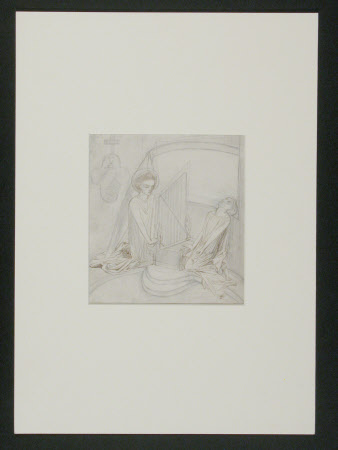St Cecilia
Elizabeth 'Lizzie' Eleanor Siddal, Mrs Dante Gabriel Rossetti (Holborn 1829 – Chatham Place, London 1862)
Category
Art / Drawings and watercolours
Date
1860
Materials
Pen and ink on paper
Measurements
215 mm (H); 200 mm (W); 535 mm (H); 380 mm (W)
Order this imageCollection
Wightwick Manor, West Midlands
NT 1288024
Summary
Pen and ink drawing - An illustration, pen and brown ink to Moxon's Tennyson; an angel kneeling opposite a fainting St Cecilia before a small alter. Glued to white paper surround, large cream card mount. Information from Beyond Ophelia, 2018 Lizzie Siddal exhibition: Her head thrown back in ecstasy at the arrival of her protector; St Cecilia is visited by an angel, heralded by heavenly organ pipes. Cecilia, a Christian, took a lifelong vow of chastity. Forced to marry a pagan, she tells him of her vow and of the angel who will protect her virtue. She persuades her husband of her beliefs, and as a result of her faith, attempts were made to kill her. These miraculously failed; and she was left to die. In the Victorian era St. Cecilia captured the imagination of a variety of artists, and as the patron saint of music is often depicted with musical instruments. Saint Cecilia is a symbol of steadfast virtue and heroism. Cecilia lived in the 2nd or 3rd century A.D. and belonged to a noble Roman family. She took a vow of chastity but was forced to marry Valerian, a pagan man. Once they were married, St. Cecilia explained her religious beliefs to her husband and he was so convinced by her that he agreed to be baptised. He even persuaded his brother to join him in his newfound Christian faith. Like many saints, St. Cecilia suffered a painful death as a result of her enduring Christian faith. Tennyson’s poem The Palace of Art was the inspiration for these drawings. In the poem a woman creates a palace of scenes and memories for her to live in, including a room where St Cecilia and the angel are: ‘I built my soul a lordly pleasure-house, / Wherein at ease for aye to dwell.’ ‘My soul would live alone unto herself / In her high palace there.’ ‘Full of long-sounding corridors it was / over-vaulted grateful gloom, / Thro' which the livelong day my soul did pass, / Well-pleased, from room to room.’ A drawing of St Cecilia by Rossetti illustrates Tennyson's poemThe Palace of Art. The pose of Rossetti's St Cecilia; with her head thrown back, eyes closed in ecstasy, and her hands resting on the organ pipes, is inspired by Siddal's earlier drawings of the saint. He, however, brings the angel and saint together in a sensual embrace. Gabriel had suggested Lizzie should contribute illustrations to the new edition, and she began working on sketches for St. Cecilia, Sir Galahad and St. Agnes' Eve, although her work was not used. Historically, female artists have rarely received the recognition for their own art. Lizzie's work has been described as an imitation of Rossetti's, yet , as St. Cecilia attests to, Rossetti drew inspiration from her work.
Provenance
Probably Charles Fairfax Murray; by descent to his son Arthur R. Murray; purchased Sotheby's 15 February 1961, part of lot 6 (an album of drawings and sketches mostly by Elizabeth Siddal); purchased by Sir Geoffrey Mander, c.£120-170 the lot; (Sir Geoffrey Mander later sold 6 of the pictures in the purchased lot to Jeremy Maas, including Siddal's Lady of Shalott); transferred to the National Trust on the death of Rosalie Glynn Grylls, Lady Mander (1905 - 1988)
Marks and inscriptions
By Lizzie R St Cecilia (Tennyson) Small (signed in pencil though crossed through)
Makers and roles
Elizabeth 'Lizzie' Eleanor Siddal, Mrs Dante Gabriel Rossetti (Holborn 1829 – Chatham Place, London 1862), artist
References
Jacobi and Finch 2023: Carol Jacobi and James Finch (eds.), The Rosettis, exh.cat. Tate Britain, London and Delaware Art Museum, 2023, no. 123, p. 122.


